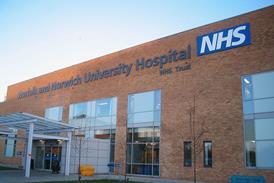The NHS can learn many of the lessons from the 20 years of success in the school improvement movement, writes Ian Kershaw
A few weeks ago Monitor placed Queen Elizabeth Hospital King’s Lynn Foundation Trust in “special measures”, thereby joining 11 others identified earlier this year.
It is unlikely that more than one in a thousand NHS staff would have the slightest idea of the concept of special measures, in the same way that no one knew what it meant in 1993 when the first school in England was placed in that category.
‘Hospitals are organisations where “every patient matters”, in much in the same way that “every child matters” for a school’
Those of us in the business of school improvement have worked out what it means to address special measures over a long period. We know that it means a loss of a school’s autonomy, leading to the imposition of an executive improvement board to take responsibility for the management of rapid change and transfer of the school to an academy trust.
In the school improvement business we understand that there are clear, measurable criteria applied by inspectors to inform judgements about the quality of outcomes, provision and leadership. We know that the criteria for determining quality have been raised at regular intervals over the past 20 years, so that the threshold for failure is now set at a far higher standard than in 1993.
It is clear that the secretary of state and the Care Quality Commission are determined to learn many of the lessons from the 20 years of success in the school improvement movement. Over that time we have learnt that there is a rhythm to the school inspection and improvement relationship which the NHS can learn from.
Why it works
One of the main reasons the inspection system in education works is that after 20 years a science and practice of school improvement has thrived alongside it. This means that following inspection the board of governors or sponsors of academies can get hold of any number of specialist school improvement organisations to work with them to address issues raised in the report.
My own organisation, Northern Education, has developed around the expertise of many experienced or former headteachers who have a proven record in leading schools. However, simply being good at something does not mean that you are good at providing the sensitive support and robust challenge that is required. Nor does it mean that you have the analytical and organisational development skills needed for the context of another school. Over the years, we have learnt to develop good headteachers into good improvement professionals.
‘I have sensed a fatalism in the NHS that once a trusts is put in “special measures” it is doomed to have the label forever’
Our task is to ensure that the schools we work with have the opportunity to work with ideas, experience, expertise and networks of outstanding practice outside their own in order to improve.
While I recognise that hospitals are more complex organisations than schools, with many more specialist services and professionals, the common denominator is that hospitals are organisations where “every patient matters”, in much in the same way that “every child matters” for a school. As in schools, the quality of services provided and the outcomes are a product of the climate and the systems created by the leadership of the organisation.
What lessons can 20 years of school improvement offer to hospitals that find themselves placed into special measures and requiring rapid improvement?
Improvement does happen
First and most importantly it is essential to recognise that with very hard work it is possible to improve. I mention this because I have sensed a fatalism within the NHS that once a trusts is put in “special measures” it is doomed to have the label forever.
Yet many schools placed into special measures achieve rapid improvements in the key performance indicators. For example, the percentage of students achieving five or more A*-C GCSEs with English and maths can rise in a secondary schools by as much as 30 per cent within 18 months. What that means is that 30 per cent of the students who have been taught for three years previously in an inadequate school can, within 18 months, obtain life-changing results. Improvement does happen and it can happen quickly.
‘Many schools placed into special measures achieve rapid improvements in the key performance indicators’
The second lesson is that improvement strategies are transferable between industries. It is possible to learn what works and what does not by seeking out experience from within the school improvement industry. It is interesting to note Jeremy Hunt has used the idea of a “super head” to assist hospitals that are in special measures. Experience tells us that this is more likely to work in some contexts, but not in all.
We know that co-planning strategies for improvement with experienced middle leaders from good schools works. This is likely to be the case in hospitals, where experienced team leaders from one hospital can be drawn in to work alongside colleagues in another.
The third lesson to draw upon is that the inspection framework for hospitals will provide opportunities for recovery. Given the 20 years’ experience in school improvement, it would be a pity if some of that is not used to short circuit what might otherwise take two decades to learn.
Ian Kershaw is the managing director of Northern Education


























6 Readers' comments